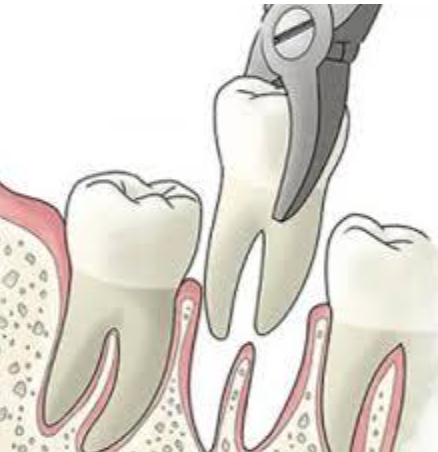EXTRACTIONS
Service description
Tooth extraction is a procedure where a tooth or teeth are removed by an Oral or Maxillofacial Surgeon using dental tools and equipment. Also Known as oral surgery, it is a simple technical procedure that usually requires local or general anesthesia or sedation. Like any other minor surgeries, careful medical evaluation is necessary before tooth extraction is performed. The procedure is accompanied with pain management for maximum patient comfort.
DESCRIPTION
The procedure will take place in the dental office or hospital dental clinic. It may involve removing one or more teeth. You may be asked to take antibiotics before the procedure.
You will get a local anesthetic to numb the area around the tooth, so you do not feel pain.
Your oral surgeon may loosen the tooth in the gum using a tooth removal instrument called an elevator.
Your dentist will then place forceps around the tooth and extract the tooth out from the gum.
If you need a more complex tooth extraction:
You may be given sedation, so you are relaxed and asleep, as well as an anesthetic so you are pain-free.
The surgeon may need to remove several teeth using the methods above.
For an impacted tooth, the surgeon may have to cut a flap of gum tissue and remove some surrounding bone. The tooth will be removed with forceps. If it is hard to remove, the tooth may be sectioned (broken) into pieces.
After your tooth is removed:
Your surgeon will clean out the gum socket and smooth out the bone that is left.
The gum may need to be closed with one or more stitches, also called sutures.
You will be asked to bite down on a damp piece of gauze to stop the bleeding.
There are several reasons people have a tooth pulled:
A deep infection in a tooth (abscess)
Overcrowded or poorly positioned teeth.
Gum disease that loosens or damages teeth.
Tooth injury from trauma
Impacted teeth that are causing problems, such as wisdom teeth (third molars)
RISKS
While uncommon, certain problems may occur:
The blood clot in the socket falls out days after the extraction (this is known as dry socket)
Infection
Nerve damage
Fractures caused by instruments used during the procedure.
Damage to other teeth or restorations
Bruising and swelling at the treatment site
Discomfort or pain at the injection site
Incomplete relief of pain
Reaction to local anesthesia or other medicines given during or after the procedure.
Slow healing of wounds
BEFORE THE PROCEDURE
Tell your surgeon about any medicines you take, including over-the-counter medicines, and about your medical history. A tooth extraction can introduce bacteria into the bloodstream. So be sure to tell your surgeon if you have or have had conditions that may make you prone to infection. These may include:
Heart disease
Liver disease
Weakened immune system.
Recent surgery, including heart surgery and bone and joint procedures that involve metal hardware.
Lung disease
Bleeding disorder
AFTER THE PROCEDURE
You may go home shortly after the procedure.
You will have gauze in your mouth to stop the bleeding. This will also help a blood clot to form. The clot fills the socket as the bone grows back in.
Your lips and cheek may be numb, but this will wear off in a few hours.
You may be given an ice pack for your cheek area to help keep swelling down.
As the numbing medicine wears off, you may begin to feel pain. Your surgeon will recommend pain relievers, such as ibuprofen (Motrin, Advil). Or you may be given a prescription for pain medicine.
You will be given a post-op instruction how to take care of yourself after procedure.
OUTLOOK (PROGNOSIS)
Everyone heals at a different rate. It will take 1 to 2 weeks for the socket to heal. Affected bone and other tissue may take a bit longer to heal. Some people may have changes to the bone and tissue near the extraction.
You should call your oral surgeon if you have:
Signs of infection, including fever or chills
Severe swelling or pus from the extraction site
Continued pain several hours after extraction.
Excessive bleeding several hours after extraction
The blood clot in the socket falls out (dry socket) days after the extraction, causing pain.
Rash or hives
Cough, shortness of breath, or chest pain
Trouble swallowing
Other new symptoms


